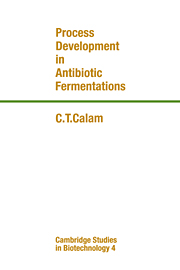Book contents
- Frontmatter
- Contents
- Preface
- Part 1 Background
- Part 2 Process development in the laboratory
- Part 3 Industrial fermentation plants and pilot plants
- 11 Fermentation plants and pilot plants
- 12 Process development in the fermentation plant
- 13 Two plant problems: infection and variations in the level of production
- Postscript
- Bibliography
- References
- Index
11 - Fermentation plants and pilot plants
Published online by Cambridge University Press: 05 February 2012
- Frontmatter
- Contents
- Preface
- Part 1 Background
- Part 2 Process development in the laboratory
- Part 3 Industrial fermentation plants and pilot plants
- 11 Fermentation plants and pilot plants
- 12 Process development in the fermentation plant
- 13 Two plant problems: infection and variations in the level of production
- Postscript
- Bibliography
- References
- Index
Summary
The antibiotics factory
Although antibiotics process development is concerned with the fermentation stage of manufacture, it forms part of the activities of a group of works units which involve all stages of production. It is therefore important to appreciate the scope of the activities that are included in a typical antibiotics factory. It is likely that such a plant will include the following facilities or work areas.
(a) Basic physical inputs: steam raising, electricity, water, and effluent disposal.
(b) Laboratories for analysis and for the production of seed cultures for the fermentation plant.
(c) The fermentation building and its ancillary equipment.
(d) Development facilities, often in the form of a pilot plant.
(e) Filtration and extraction buildings.
(f) Plant for the preparation of pharmaceutical products for sale.
(g) Engineering maintenance facilities of various types.
(h) Management and administration.
Works buildings are commonly referred to as “sheds”. This has no derogatory significance, and will be adopted in later descriptions.
All these facilities are of great importance for success, and have their own operational methods and considerations. For example, steam, electricity, and water are used to a very large extent, each costing millions of pounds per year. Water is important for cooling the fermenters, and it is often necessary to provide for the cooling of the water and for re-cycling, especially in warm weather, to make effective use of it. One plant employs a large refrigeration system for this purpose. Many plants have to provide treatment units to bring down the biological oxygen requirement of the effluent before it can be discharged.
- Type
- Chapter
- Information
- Process Development in Antibiotic Fermentations , pp. 151 - 173Publisher: Cambridge University PressPrint publication year: 1987

